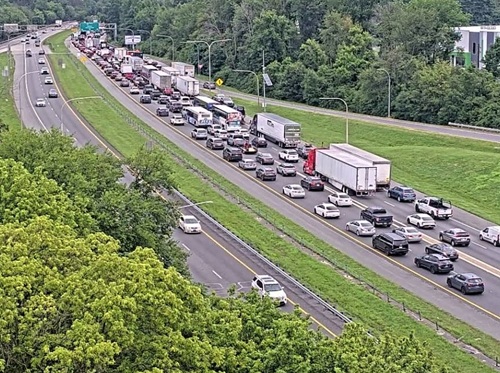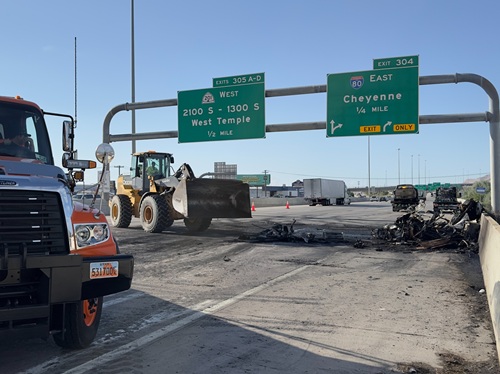National transportation research nonprofit TRIP has issued a report that examines U.S. traffic fatality trendlines over the last few years.
[Above photo by Utah DOT]
TRIP noted in its report that U.S. traffic fatalities declined in 2024 for the third straight year after surging in 2020 and 2021 as the nation grappled with the impact of the COVID-19 pandemic.
However, traffic fatalities in 2024 remained significantly higher compared to a decade ago; up 20 percent in 2024 compared to 2014’s figures.

“While it is good news that the number of traffic fatalities is trending downward in recent years, the sharp increase in traffic fatalities over the past decade must be addressed,” said Dave Kearby, TRIP’s executive director, in a statement.
“Making a commitment to eliminating fatal and serious injuries on the nation’s roadways will require robust investment and coordinated activities by transportation and safety-related agencies in providing the needed layers of protection for the nation’s motorists, pedestrians, and bicyclists – including safe road users, safe roads, safe vehicles, safe speeds and high-quality post-crash care,” he added.
TRIP’s new report – Addressing America’s Traffic Safety Crisis: Examining the Causes of Increasing U.S. Traffic Fatalities and Identifying Solutions to Improve Traffic Safety – documents trends in traffic fatalities from 2014 to 2024 at the national and state levels and examines causes for the increase in traffic fatalities. It also prescribes a broad and comprehensive approach to reducing U.S. traffic fatalities now and in the future.
The report’s Appendix includes the number of fatalities and the fatality rate per 100 million vehicle miles travelled or VMT every state and the District of Columbia for 2014 and 2019-2024.
In 2011 U.S. traffic fatalities dropped to 32,749, the lowest level since 1949 when there were 30,246 traffic fatalities. However, by 2018, U.S. traffic fatalities had increased to 36,835. Beginning in March 2020, when initial restrictions due to the COVID-19 pandemic were implemented, the number and rate of traffic fatalities began to increase, even as the rate of vehicle travel decreased dramatically.

The significant increase in traffic fatalities since the onset of the pandemic appears largely related to increased risks being taken by drivers, TRIP said. In an October 2021 report, the National Highway Traffic Safety Administration found that “after the declaration of the public health emergency in March 2020, driving patterns and behaviors in the United States changed significantly. Of the drivers who remained on the roads, some engaged in riskier behavior, including speeding, failure to wear seat belts, and driving under the influence of alcohol or drugs.”
[Editor’s note: A study issued by the Insurance Institute for Highway Safety in early July also discerned some of the same factors driving that spike in traffic crashes and fatalities.]
Based on National Highway Traffic Safety Administration crash cost methodology unveiled in 2023, TRIP estimates that fatal and serious traffic crashes in 2024 caused a total of $1.83 trillion in the value of societal harm, which includes $455 billion in economic costs and $1.38 trillion in quality-of-life costs.
NHTSA data also found that the number of people killed in speeding-related traffic crashes climbed 16 percent from 2019 to 2024 – representing 28 percent of U.S. traffic fatalities in 2024. From 2019 to 2023, the number of fatalities in distraction-affected traffic crashes increased by five percent, from 3,119 to 3,275.
Additionally, from 2019 to 2023, crashes in U.S. highway work zones resulted in 4,470 fatalities – an increase of 6 percent from 845 in 2019 to 898 in 2023. TRIP noted the Appendix of its new report includes the number of work zone fatalities in each state and nationwide from 2019 to 2023.

Jim Tymon, executive director of the American Association of State Highway and Transportation Officials, noted that state departments of transportation remain committed to maintaining the ongoing U.S. decline in traffic crashes and fatalities.
“State DOTs across the country are encouraged to see progress in driving down roadway fatalities, but we still have so far to go,” he said. “While safety has always been the top priority for state DOTs, AASHTO members continue to look for ways to make impactful changes.”
Tymon noted that state DOTs are focusing on “centering safety” as part of this effort – ensuring safety is at the center of every action they take.
“As we look to the next federal surface transportation reauthorization, we see an opportunity to make robust investments in our transportation networks and build on the successes we have seen the last few years in reducing the number of roadway fatalities,” he pointed out.
TRIP noted that increasing investment in roadway safety improvements is likely to pay off in the form of reduced fatal and serious traffic crashes.
The nonprofit said the U.S. has a $146 billion backlog in needed roadway safety improvements, according to a 2017 report from the AAA Foundation for Traffic Safety.
That report found implementing cost-effective and needed roadway safety improvements on U.S. roadways would save approximately 63,700 lives and reduce the number of serious injuries due to traffic crashes by approximately 350,000 over a 20-year period.
 Top Stories
Top Stories
Modal Administrators Speak at AASHTO Annual Meeting
December 5, 2025 Top Stories
Top Stories

